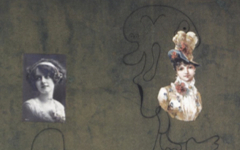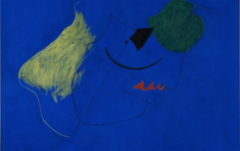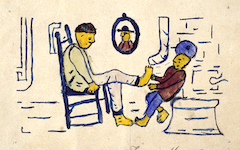Miró‘s Birds in Space (1946)
Up until 1928 Joan Miró had “devoted excruciating care to the rendering, scale, and placement of his name within the composition of [his] works.”1 And then, according to experts, he stopped. He stopped signing works on the front of his canvasses, “renouncing one of the most traditional symbols of individual authenticity.”2 Yet, EPPH has already shown that seven works by Miró after that date contain his name in a much larger form than a signature.3 One is a sculpture. By the 1920's, however, Miró was interested in the Inner Tradition, especially in spiritual alchemy and its search for self-knowledge.4 Alchemy, like other esoteric paths, uses allegory and metaphor to veil its true message from the uninitiated. It seems likely, therefore, that once committed, Miró hid his name and its significance from the unknowing viewer.

Miró, Birds in Space (!946) Oil on canvas. 145.5 x 113.5 cm. Museo de Arte Reina Sofia, Madrid
Click image to enlarge.
Birds in Space (left) from 1946 is another good example. Given the title, which may have been chosen after completion, there seem to be two flocks of birds of different sizes circling across the sky. It's as though we see the traces of their flight path. Metaphorically, we might instead be looking at an example of blue-sky thinking, a flight of thoughts whirling their way through the mind. And, since all thoughts by definition reflect their host, each of these flying thoughts must represent Miró.
Click next thumbnail to continue

Four details of Miró's Birds in Space, rotated and/or inverted with letter-guide added.
Click image to enlarge.
At left you can see how five of the smaller squiggles "spell" the artist's own name. Very roughly, that is, with some of the letters twisted. The zig-zag of the M and the rounded Ó, the first and last letters of his name, are the most visibly recognizable. The middle ones are rendered less clearly as if in his hand-written signature, lower-case obviously and unlike any regular font. In the second example at left, the letter i merges with the last upright of the M. Look closely and you'll see how he indicated it with a slight thickening of the line.
The meaning of an artist's name is often significant. Miró's is linked to the Spanish verb to look (mirar) and to the Latin miror which became, in English, mirror.5 Perhaps that is why in the last example at left Miró's own name is reflected as MiróóriM. {Follow the arrows to see how.] Nevertheless, all art is the artist's reflection so the inverted doubling makes sense anyway.
Click next thumbnail to continue
This painting is yet another demonstration of a paradox Miró must have delighted in: even though he stopped signing his works in 1928, he did not stop signing his works. He always stressed as well that though his works might seem abstract, they were not. He could not even understand those who thought they were "as if the marks I put on a canvas did not correspond to a concrete representation of my mind, did not possess a profound reality, were not part of the real itself?”6
More Works by Miró
One way to make sense of Miró's abstractions is to remember, as ever, that 'every painter paints himself.'

Miró‘s Drawing-Collage (1933)
Notes:
1. Joan Miró: Painting and Anti-Painting, 1927-1937 (New York: Museum of Modern Art) 2008, p.54
2., ibid., p.10
3. See Abrahams, "Miró's Name in Miró's Art (1937-69)", "Miró's Painting (1933)", "Miró's Painting/The Circus Horse (1927)" and "Miró's Potato (1928)". The presence of Miró's name in a canvas or sculpture is one of his art's most characteristic features. I have dozens more to show unpublished.
4. Corinne Mandel, "Miró's Mystical Mollusks", Mediterranean Studies 5, 1995, pp. 113-5
5. The original meaning of the Latin miror, to wonder at, had been used by the early Kabbalists. Zhenya Gershman, "Rembrandt: Turn of the Key", Arion 21, Winter 2014, p. 25, n.17 and on EPPH.
6. Joan Miró: Painting and Anti-Painting, p.12
Original Publication Date on EPPH: 24 Oct 2014. © Simon Abrahams. Articles on this site are the copyright of Simon Abrahams. To use copyrighted material in print or other media for purposes beyond 'fair use', you must obtain permission from the copyright owner. Websites may link to this page without permission (please do) but may not reproduce the material on their own site without crediting Simon Abrahams and EPPH.


